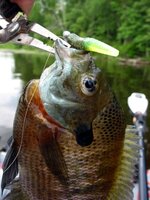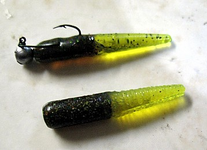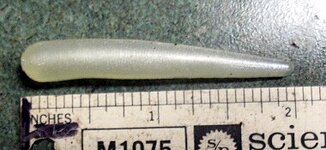SPOONMINNOW
Member
- Joined
- Oct 9, 2016
- Messages
- 261
I fished weeds mostly early on with few fish caught. Not wanting to give up, I went north to the opposite end of the lake to a rocky area devoid of weeds. Earlier at the opposite end, another rock point produced some pan fish so I figured why not a flat in shallow water 3' or less? Sure enough, school pannies were waiting for my lures! Most important was proving the potential of a lure design I had caught fish used earlier in the year, the difference being - sunnies and perch SLAMMED the lure and HELD ON for easy long-distance hooksets using 8# test braid. In no time I caught 40 fish from two schools/ 83 fish for the outing. What's more, the major catch was from 12:30 until 3:30 pm. Here's the lure that knocked my socks off (if I had worn any with my sandals):
View attachment 23165 View attachment 23167View attachment 23168View attachment 23169
Jig head weight need be only 1/24 oz for the 2.5' fish were caught in. I don't usually prefer a sickle hook, but being too lazy to change, it stayed on the line. When I say long-distance hook sets, I'm talkn' 40' or more - the weight of the lure significant.
Another design did well as usual - a curly tail hybrid connecting the tail to a larger body:
View attachment 23170
...and a straight thin tail hybrid also using a larger body:
View attachment 23172
Could the larger bodies have accounted for more and stronger strikes? The same thing for this hybrid paddle tail that kicked A along with the taper-tail:
View attachment 23173 View attachment 23174View attachment 23175
View attachment 23176
The paddle tail and thin body that attached to the thicker body, had a beautiful tight shimmy that was totally different than the wobble & dart of the taper-tail. I would have stayed longer but the wind had increased to over 25mph with waves - time to return home! Heck, 107 fish for two days - not bad; most important finding two lure designs that did well with hard strikes and easy hook sets. (BTW, hook size was #6)
View attachment 23165 View attachment 23167View attachment 23168View attachment 23169
Jig head weight need be only 1/24 oz for the 2.5' fish were caught in. I don't usually prefer a sickle hook, but being too lazy to change, it stayed on the line. When I say long-distance hook sets, I'm talkn' 40' or more - the weight of the lure significant.
Another design did well as usual - a curly tail hybrid connecting the tail to a larger body:
View attachment 23170
...and a straight thin tail hybrid also using a larger body:
View attachment 23172
Could the larger bodies have accounted for more and stronger strikes? The same thing for this hybrid paddle tail that kicked A along with the taper-tail:
View attachment 23173 View attachment 23174View attachment 23175
View attachment 23176
The paddle tail and thin body that attached to the thicker body, had a beautiful tight shimmy that was totally different than the wobble & dart of the taper-tail. I would have stayed longer but the wind had increased to over 25mph with waves - time to return home! Heck, 107 fish for two days - not bad; most important finding two lure designs that did well with hard strikes and easy hook sets. (BTW, hook size was #6)





